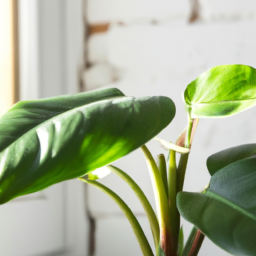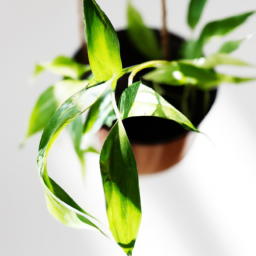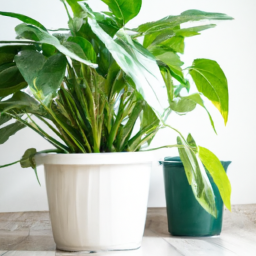
If you’re looking to improve the air quality in your home, you may be wondering, “What indoor plants clean the air?” Indoor plants not only add a touch of greenery to your space, but they can also help filter out harmful toxins and pollutants, creating a healthier environment for you and your family. In this blog post, we’ll explore some of the best indoor plants that are known for their air-purifying properties. So, if you’re ready to breathe easier and enjoy the benefits of cleaner air, keep reading to learn more about these amazing plants.
Benefits of Indoor Plants for Air Quality
Indoor plants are not only a beautiful addition to your home decor, but they also play a crucial role in improving the air quality inside your house. In today’s world, where pollution levels are on the rise, having indoor plants can act as a natural air purifier, filtering out harmful toxins and pollutants from the air. Let’s explore the various benefits of indoor plants for air quality.
1. Oxygen Production
One of the most well-known benefits of indoor plants is their ability to produce oxygen through photosynthesis. Plants take in carbon dioxide and release oxygen, which helps to increase the oxygen levels in your home. This can lead to improved air quality and a healthier living environment for you and your family.
Plants such as peace lilies, spider plants, and snake plants are known for their high oxygen production and are great choices for improving the air quality in your home. By placing these plants strategically around your living space, you can ensure a constant supply of fresh oxygen.
In addition to increasing oxygen levels, indoor plants also help to regulate humidity levels in your home. This can be especially beneficial during the dry winter months when indoor air tends to be drier. Plants release water vapor through a process called transpiration, which can help to add moisture to the air and prevent dryness.
2. Air Purification
Indoor plants are natural air purifiers, capable of removing harmful toxins and pollutants from the air. Studies have shown that certain plants can effectively filter out common indoor air pollutants such as benzene, formaldehyde, and trichloroethylene.
Plants like aloe vera, bamboo palm, and rubber plant are known for their air purifying properties and can help to improve the overall air quality in your home. These plants absorb toxins through their leaves and roots, converting them into nutrients that the plant can use for growth.
By having a variety of indoor plants in your home, you can create a natural air purification system that not only cleans the air but also adds a touch of greenery to your living space. Regularly dusting the leaves of your plants and keeping them well-watered can help to maximize their air purifying capabilities.
3. Stress Reduction
In addition to their air purifying abilities, indoor plants can also help to reduce stress and improve mental well-being. Studies have shown that being around plants can have a calming effect on the mind and body, leading to lower levels of stress and anxiety.
Plants like lavender, jasmine, and rosemary are known for their soothing aromas and can help to create a relaxing atmosphere in your home. By incorporating these plants into your living space, you can create a peaceful environment that promotes relaxation and mental clarity.
Taking care of indoor plants can also be a therapeutic activity that allows you to connect with nature and practice mindfulness. The act of watering, pruning, and caring for your plants can help to reduce stress and improve your overall mood, making indoor plants a valuable addition to any home.

Top Indoor Plants that Help Purify the Air
Introduction
When it comes to improving the air quality in your home, indoor plants are a natural and effective solution. Not only do they add a touch of greenery to your space, but many indoor plants also have the ability to filter out harmful toxins and pollutants from the air. In this article, we will explore some of the top indoor plants that can help purify the air in your home.
Peace Lily
The Peace Lily is a popular indoor plant known for its ability to remove toxins such as formaldehyde, benzene, and trichloroethylene from the air. This plant is relatively easy to care for, making it a great choice for beginners. Peace Lilies thrive in low light conditions and prefer to be kept moist but not overwatered. To keep your Peace Lily healthy and thriving, be sure to wipe its leaves regularly to prevent dust buildup and occasionally give it a gentle shower to rinse off any accumulated dirt.
Another benefit of the Peace Lily is its ability to increase humidity levels in your home, which can help alleviate symptoms of dry skin and respiratory issues. This plant is not only beautiful to look at but also serves as a natural air purifier, making it a must-have for any indoor space.
In addition to its air-purifying properties, the Peace Lily is also known for its ability to improve indoor air quality by removing mold spores from the air. This makes it an excellent choice for those who suffer from allergies or asthma. By incorporating a Peace Lily into your indoor plant collection, you can breathe easier knowing that you are surrounded by clean, fresh air.
Spider Plant
The Spider Plant is another indoor plant that is highly effective at purifying the air in your home. This plant is known for its ability to remove toxins such as formaldehyde and xylene from the air, making it a great choice for improving indoor air quality. Spider Plants are easy to care for and can thrive in a variety of lighting conditions, making them a versatile option for any indoor space.
One of the unique features of the Spider Plant is its ability to produce small plantlets, or baby spider plants, that dangle from the main plant. These plantlets can be easily propagated and grown into new plants, allowing you to expand your indoor plant collection with minimal effort. To care for your Spider Plant, be sure to water it regularly and provide it with indirect sunlight to keep it healthy and thriving.
In addition to its air-purifying properties, the Spider Plant is also known for its ability to improve mental health and reduce stress levels. Studies have shown that having indoor plants such as the Spider Plant in your home can help boost mood and productivity, making it a valuable addition to any indoor space. By incorporating a Spider Plant into your indoor plant collection, you can enjoy cleaner air and a more positive environment.
Snake Plant
The Snake Plant, also known as Mother-in-Law’s Tongue, is a popular indoor plant that is highly effective at purifying the air in your home. This plant is known for its ability to remove toxins such as formaldehyde, benzene, and trichloroethylene from the air, making it a great choice for improving indoor air quality. Snake Plants are low-maintenance and can thrive in a variety of lighting conditions, making them a versatile option for any indoor space.
One of the key benefits of the Snake Plant is its ability to produce oxygen at night, making it an ideal plant for bedrooms. This unique feature can help improve sleep quality and overall health by providing a fresh and oxygen-rich environment while you sleep. To care for your Snake Plant, be sure to water it sparingly and avoid overwatering, as this can lead to root rot.
In addition to its air-purifying properties, the Snake Plant is also known for its ability to absorb carbon dioxide and release oxygen, making it a valuable addition to any indoor space. Studies have shown that having indoor plants such as the Snake Plant in your home can help reduce indoor air pollution and create a healthier living environment. By incorporating a Snake Plant into your indoor plant collection, you can enjoy cleaner air and a more sustainable lifestyle.
In conclusion, indoor plants are a natural and effective way to improve the air quality in your home. By choosing plants such as the Peace Lily, Spider Plant, and Snake Plant, you can enjoy cleaner air, reduce indoor air pollution, and create a healthier living environment. Incorporating these top indoor plants into your indoor plant collection can help you breathe easier and enjoy the many benefits of clean, fresh air.

What Indoor Plants Clean the Air
Indoor plants not only add a touch of nature to your home or office but also have the ability to purify the air around you. They can help remove toxins and improve air quality, making your indoor environment healthier and more pleasant to be in. In this article, we will explore some of the best indoor plants that clean the air and provide you with a guide on how to choose the right plants for your space.
Benefits of Indoor Plants
Before we dive into the specific plants that clean the air, let’s first understand why indoor plants are beneficial for your health and well-being. Indoor plants have been shown to reduce stress, boost mood, and increase productivity. They also help to purify the air by removing harmful toxins and pollutants, such as formaldehyde, benzene, and trichloroethylene. By incorporating indoor plants into your space, you can create a healthier and more vibrant environment for yourself and your family.
Indoor plants can also help to increase humidity levels in your home, which is especially beneficial during the dry winter months. They release moisture through a process called transpiration, which can help alleviate dry skin, sore throats, and other respiratory issues. Additionally, indoor plants can act as natural air purifiers, absorbing carbon dioxide and releasing oxygen through photosynthesis. This can help improve air quality and create a more oxygen-rich environment in your home.
When choosing indoor plants that clean the air, it’s important to consider factors such as the plant’s size, maintenance requirements, and air-purifying abilities. Some plants are more effective at removing specific toxins from the air, so it’s helpful to choose a variety of plants to target different pollutants. By strategically placing these plants throughout your home or office, you can create a healthier and more harmonious indoor environment.
Top Indoor Plants that Clean the Air
There are several indoor plants that are known for their air-purifying properties and ability to remove toxins from the air. Here are some of the top plants that you can consider adding to your indoor space:
1. Snake Plant
The snake plant, also known as mother-in-law’s tongue, is a popular indoor plant that is easy to care for and can help purify the air in your home. It is particularly effective at removing formaldehyde, benzene, and trichloroethylene from the air. The snake plant is a great choice for beginners, as it requires minimal water and can thrive in low light conditions. Place a snake plant in your bedroom or living room to enjoy its air-purifying benefits.
In addition to its air-purifying abilities, the snake plant is also known for its unique appearance, with tall, upright leaves that resemble a snake’s tongue. It can add a touch of greenery to your space and create a calming and serene atmosphere. Consider adding a snake plant to your indoor plant collection to improve air quality and enhance the aesthetic of your home.
To care for a snake plant, place it in a well-draining potting mix and water it sparingly, allowing the soil to dry out between waterings. Avoid overwatering, as this can cause root rot and other issues. Keep your snake plant in indirect sunlight and fertilize it occasionally during the growing season to promote healthy growth.
2. Spider Plant
The spider plant is another popular indoor plant that is known for its air-purifying properties and easy maintenance. It can help remove toxins such as formaldehyde and xylene from the air, making it a great choice for improving indoor air quality. The spider plant is also safe for pets, so you can enjoy its air-purifying benefits without worrying about your furry friends.
One of the unique features of the spider plant is its ability to produce baby spider plants, or “spiderettes,” which dangle from the main plant on long, thin stems. These baby plants can be propagated and grown into new spider plants, making it a fun and rewarding plant to care for. Place a spider plant in a hanging basket or on a high shelf to showcase its cascading foliage and enhance the visual appeal of your space.
To care for a spider plant, place it in bright, indirect sunlight and water it regularly, allowing the soil to dry out between waterings. Spider plants prefer well-draining soil and can benefit from occasional fertilization during the growing season. Trim any brown or yellow leaves to promote healthy growth and keep your spider plant looking its best.
3. Peace Lily
The peace lily is a popular indoor plant that is known for its elegant white flowers and air-purifying abilities. It can help remove toxins such as formaldehyde, benzene, and trichloroethylene from the air, making it a great choice for improving indoor air quality. The peace lily is also easy to care for and can thrive in low light conditions, making it a versatile plant for any indoor space.
In addition to its air-purifying properties, the peace lily is also known for its ability to help reduce mold spores in the air, making it a great plant for allergy sufferers. It can help create a cleaner and healthier indoor environment by removing pollutants and allergens from the air. Place a peace lily in your bedroom or office to enjoy its air-purifying benefits and elegant beauty.
To care for a peace lily, place it in a well-draining potting mix and water it regularly, allowing the soil to dry out slightly between waterings. Peace lilies prefer high humidity levels, so consider misting the leaves occasionally or placing a humidifier nearby to create a more humid environment. Avoid overwatering, as this can cause root rot and other issues. With proper care, your peace lily will thrive and bring beauty and freshness to your indoor space.
Here’s what we learned
Indoor plants not only add a touch of greenery to your living space but also have the ability to clean the air by removing harmful toxins. Some of the best indoor plants for purifying the air include the spider plant, which is known for its ability to remove formaldehyde and xylene from the air. The snake plant is another great option, as it is able to filter out benzene, formaldehyde, trichloroethylene, and xylene.
Another popular indoor plant for air purification is the peace lily, which can help remove ammonia, benzene, formaldehyde, and trichloroethylene from the air. The Boston fern is also a good choice, as it is effective at removing formaldehyde and xylene. These plants not only enhance the aesthetic appeal of your home but also contribute to a healthier indoor environment by improving air quality. So, if you’re looking to freshen up the air in your home, consider adding some of these air-purifying plants to your indoor space.
Here are this week’s Top Questions and Answers
Q1: Which indoor plants are known for cleaning the air?
A1: Some popular indoor plants that are known for their air-purifying qualities include spider plants, pothos, peace lilies, snake plants, and rubber plants.
Q2: How do indoor plants help clean the air?
A2: Indoor plants help clean the air by absorbing harmful toxins such as formaldehyde, benzene, and trichloroethylene through their leaves and roots, and converting them into oxygen through the process of photosynthesis.
Q3: Do all indoor plants have air-purifying qualities?
A3: Not all indoor plants have air-purifying qualities. Some plants are more effective at removing toxins from the air than others. It’s important to choose the right plants based on your specific air quality needs.
Q4: How many indoor plants should I have to effectively clean the air in my home?
A4: The number of indoor plants needed to effectively clean the air in your home depends on the size of your space and the types of toxins present. In general, having 1-2 plants per 100 square feet of space is a good rule of thumb.
Q5: Are there any low-maintenance indoor plants that clean the air?
A5: Yes, there are several low-maintenance indoor plants that have air-purifying qualities, such as snake plants, pothos, and spider plants. These plants require minimal care and are great options for beginners or those with busy schedules.
Dr. Olivia Green is a botanist with over two decades of experience in indoor plant cultivation. She holds a Ph.D. in Plant Biology and has dedicated her career to researching plant behavior in controlled environments. Dr. Green is passionate about helping plant enthusiasts master the art of indoor gardening through her extensive knowledge and practical insights.


